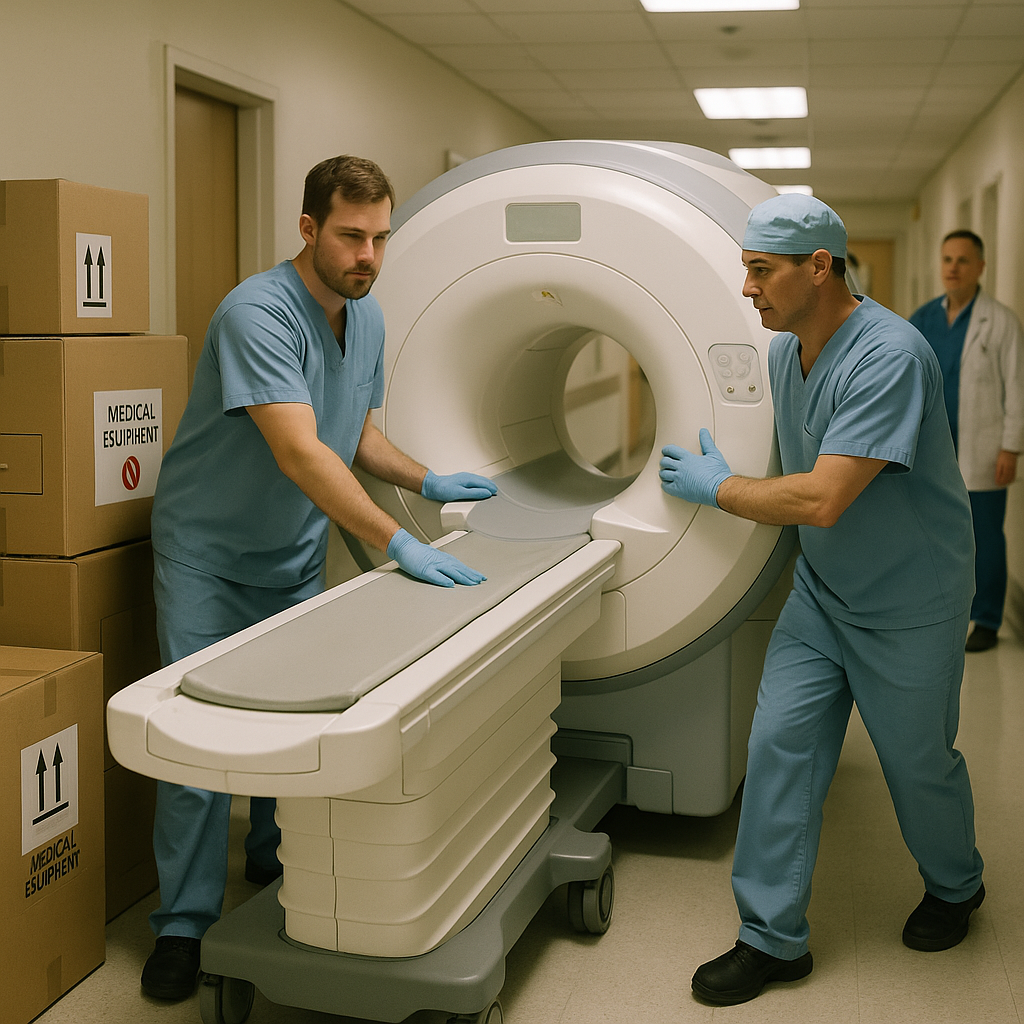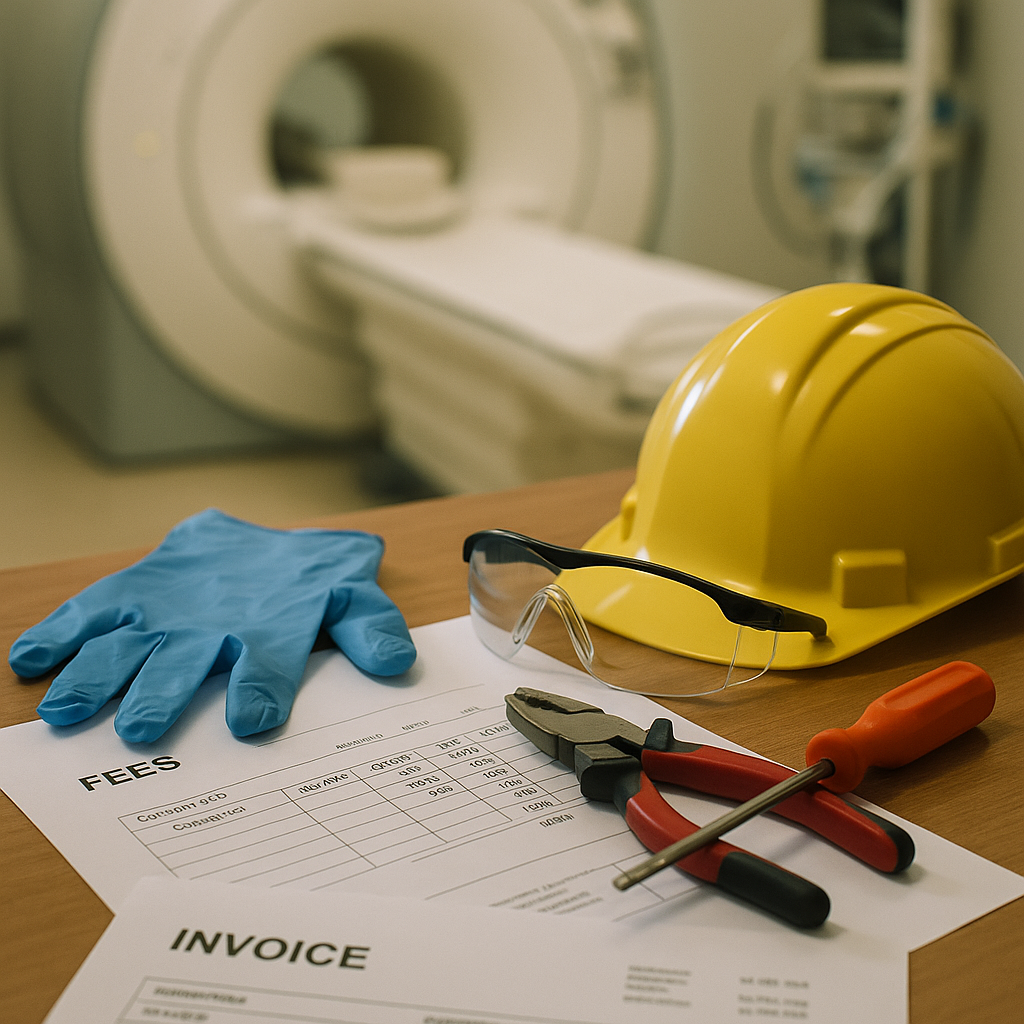5901 Botham Jean Blvd, Dallas, TX 75215
Cost to Remove an MRI Scanner: Factors, Pricing Breakdown, and Key Considerations
September 9, 2025Removing an MRI scanner from a healthcare facility typically costs between $10,000 and $12,000 in standard situations. This cost covers the basic de-installation process, including safely powering down the system, disconnecting components, and removing the equipment from your facility. The process usually takes a few days to complete, depending on the complexity of your specific setup.
Several factors can increase costs beyond the base range. The location of your MRI machine significantly affects removal expenses. Machines in basement levels or upper floors often require specialized equipment like cranes or wall removals, adding thousands to the final bill. Similarly, older facilities with narrow doorways or hallways present logistical challenges that increase labor hours and costs.
The price also varies based on technical requirements. MRI magnets must be safely ramped down from their operating field, which requires expensive power supplies. These specialized components can add $6,000 to $12,000 to your removal costs. Understanding these variables helps healthcare administrators budget appropriately for this significant operational change.
What Factors Affect the Cost of MRI Scanner Removal?

Removing an MRI scanner is complex, requiring careful planning and specialized expertise. Several key factors can significantly impact the cost of MRI scanner removal. Understanding these factors can help healthcare facilities plan and budget effectively for this process.
Facility Layout and Access Constraints
The physical characteristics of the facility play a crucial role in determining removal costs. Buildings with narrow doorways, tight corridors, or multiple floors present significant challenges. In some cases, walls, doors, or windows must be temporarily removed to create a sufficient pathway for the equipment.
For facilities lacking knockout panels (removable wall sections), creating access routes becomes more labor-intensive and costly. Some buildings require cranes to extract the scanner through windows or rooftop openings when internal pathways are insufficient. These additional structural modifications and specialized equipment rentals can substantially increase the project’s overall cost.
Magnet Decommissioning Requirements
A critical and potentially expensive aspect of MRI scanner removal is safely powering down the magnet. This process, known as quenching or ramping down, requires specialized power supplies and technical expertise to safely dissipate the magnetic field without damaging the equipment or facility.
The cost for proper magnetic field reduction typically ranges from $6,000 to $12,000, depending on the scanner type and field strength. MRI machines with higher tesla ratings generally require more sophisticated decommissioning procedures. Skipping this crucial step can lead to dangerous consequences, including damage to the facility or injury to personnel.
Transportation Distance and Logistics
The distance between your facility and the scanner’s destination directly impacts transportation costs. Long-distance moves require specialized climate-controlled transportation to protect sensitive components, particularly if the scanner will be reused or resold.
Additional logistical factors affecting cost include:
- Need for temporary storage facilities
- Special permits for oversized loads
- Security requirements during transit
- Insurance costs for high-value equipment
Scanner Type and Age
The specific make, model, and age of your MRI scanner also influence removal costs. Newer models may have different disassembly requirements than older units. Similarly, scanners from different manufacturers (GE, Siemens, Philips) have unique disassembly protocols that may require manufacturer-specific expertise.
Older systems can contain materials or components that require special handling or disposal considerations, potentially adding to the overall project cost.
Project Timeline and Scheduling
Projects with tight deadlines often incur premium charges for expedited service. Conversely, projects with flexible timelines allow for more cost-effective planning and resource allocation. Weekend or after-hours work to minimize disruption to facility operations will typically result in higher labor costs.
Proper planning and allowing adequate lead time for MRI scanner removal can help control costs while ensuring the process is completed safely and efficiently.
| Factor | Description | Cost Impact |
|---|---|---|
| Facility Layout and Access Constraints | Presence of narrow doorways, multiple floors, or need for cranes | Increases costs significantly |
| Magnet Decommissioning Requirements | Safely quenching or ramping down magnet fields | $6,000 to $12,000 |
| Transportation Distance and Logistics | Long-distance moves requiring climate-controlled transport | Varies with distance and needs special permits for oversized loads |
| Scanner Type and Age | Disassembly requirements vary based on make, model, and age | Older systems may require special handling |
| Project Timeline and Scheduling | Tight deadlines and weekend work | Increases labor costs |
How Does MRI Scanner Removal Fit into Overall Relocation Costs?

MRI scanner removal is a crucial aspect of the broader relocation process. The entire MRI relocation typically costs between $60,000 and $100,000, covering three main phases: de-installation, transportation, and re-installation.
De-installation involves dismantling the MRI system carefully, requiring specialized expertise to handle sensitive components. This stage often necessitates power supplies to safely ramp down the magnet from its operating field, with costs ranging from $6,000 to $12,000. The complexity of the exit path—such as the need for wall removal or cranes—can significantly affect these costs.
Transportation is generally straightforward but varies based on distance. Shipping an MRI within the country typically costs $5,000 to $10,000. Greater distances increase expenses for fuel, driver hours, specialized packaging, and suitable vehicles for safely moving these sensitive systems.
Re-installation incurs the highest costs, ranging from $50,000 to $80,000 for a standard 1.5T MRI system. This phase may require extensive site preparation, including RF shielding installation, cable routing, chiller connections, and magnet field shimming. Additional costs arise if the new location has never housed an MRI, requiring more extensive infrastructure modifications.
Efficient planning of each relocation phase minimizes environmental impact. Effective de-installation preserves components for reuse, while optimized transportation routes reduce carbon emissions. Re-installation using existing infrastructure minimizes construction waste and resource consumption.
The resource recovery aspect is essential. When an MRI system reaches end-of-life during relocation assessment, specialized recycling becomes crucial. Valuable materials within these systems, including copper, aluminum, and other metals, can be reclaimed through proper disposal channels, supporting circular economy principles.
Proper management of helium, a non-renewable resource used in MRI cooling systems, is another critical environmental consideration during relocations. Responsible capture and recycling of helium during de-installation prevent unnecessary releases of this scarce element into the atmosphere.
Beyond immediate financial considerations, facilities must evaluate the long-term environmental costs of their relocation decisions. A slightly higher investment in sustainable relocation practices often yields significant ecological benefits while potentially reducing operational costs over the equipment’s extended lifespan.
What Additional Costs Should Be Considered When Removing an MRI Scanner?

Removing an MRI scanner involves more than just the transportation expenses. Planning for these additional costs upfront helps prevent budget overruns and ensures a smooth transition during equipment upgrades or replacements.
Site Restoration Requirements
The MRI suite will require significant restoration work after scanner removal. Most facilities need to restore floors where weight-distributing platforms were installed. Wall repairs are often necessary where RF shielding was attached, and ceiling modifications may be needed where specialized ventilation systems were installed.
The restoration process might also involve removing specialized electrical systems designed for the high power demands of MRI equipment. These circuits are often not reusable for other medical equipment without modification.
Building Modification Considerations
Your facility might need structural reinforcement if the MRI scanner served as support for surrounding structures. Doorways or walls widened for the original installation may need to be restored to their standard dimensions. Removing RF shielding can also expose underlying structural issues that need addressing.
Depending on future plans for the space, you may need to update HVAC systems, as the thermal load requirements for MRI suites differ significantly from standard medical spaces.
Scanner Disposal and Recycling Options
Proper disposal of an MRI scanner requires specialized knowledge of hazardous materials handling. The scanner contains valuable metals and components that should be recovered through appropriate recycling channels. Some manufacturers offer trade-in programs to offset new equipment costs.
Environmental regulations strictly govern the disposal of MRI components, especially those containing rare earth metals. Facilities must obtain proper documentation of disposal to maintain compliance with local regulations.
Ongoing Financial Obligations
Even after removal, certain financial obligations may continue. Service contracts often include early termination fees if canceled before their end date. Maintenance agreements ranging from $2,000 to $10,000 per month may have remaining term obligations.
Energy expenses, which typically vary from $50 to $3,000 per month depending on scanner size and usage, will cease. However, the facility may need to adjust its utility contracts and capacity planning when removing high-consumption equipment.
Decommissioning Specialized Systems
Cryogen recovery systems require professional decommissioning. Liquid helium must be properly extracted and stored by certified technicians. Quench pipes and emergency ventilation systems need proper capping and sealing.
The specialized MRI cooling systems often contain materials requiring certified handling during removal. These cooling components may contain chemicals that need proper disposal under environmental regulations.
Inadequate planning for these additional costs can significantly impact the total expense of your MRI replacement project. Working with experienced removal specialists can help identify potential hidden costs before they become budget problems.
Conclusion: Planning for Cost-Effective MRI Scanner Removal

Removing an MRI scanner is a complex task that requires careful planning and consideration of various factors. This article has discussed how costs can vary significantly—from about $10,000 for basic removal services to much higher amounts depending on site-specific challenges, transportation distances, and specialized handling requirements. The complexity arises from the need to safely manage powerful magnets, sensitive electronic components, and bulky equipment through spaces not designed for easy extraction.
Strategic planning is key to cost-effective MRI removal. Facilities that conduct thorough site assessments, document exit pathways, and plan for potential structural modifications achieve more predictable outcomes and avoid costly surprises. Obtaining detailed quotes from multiple experienced service providers ensures competitive pricing, helps understand the full scope of the removal process, and identifies potential challenges before they become expensive issues.
For healthcare facilities focused on optimizing their medical equipment lifecycle management, consider contacting Okon Recycling at 214-717-4083. Our team specializes in environmentally responsible, cost-effective solutions for MRI scanner removal and recycling.
